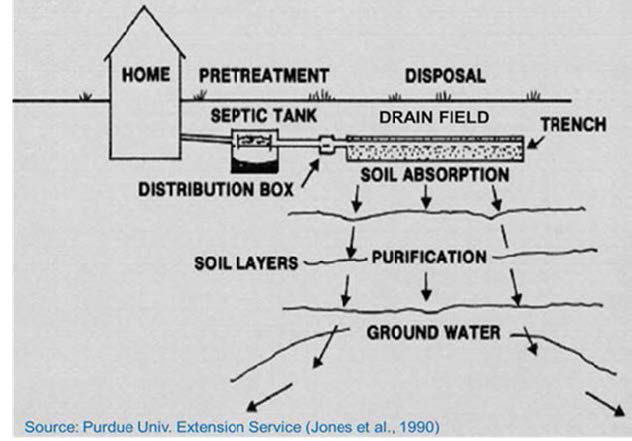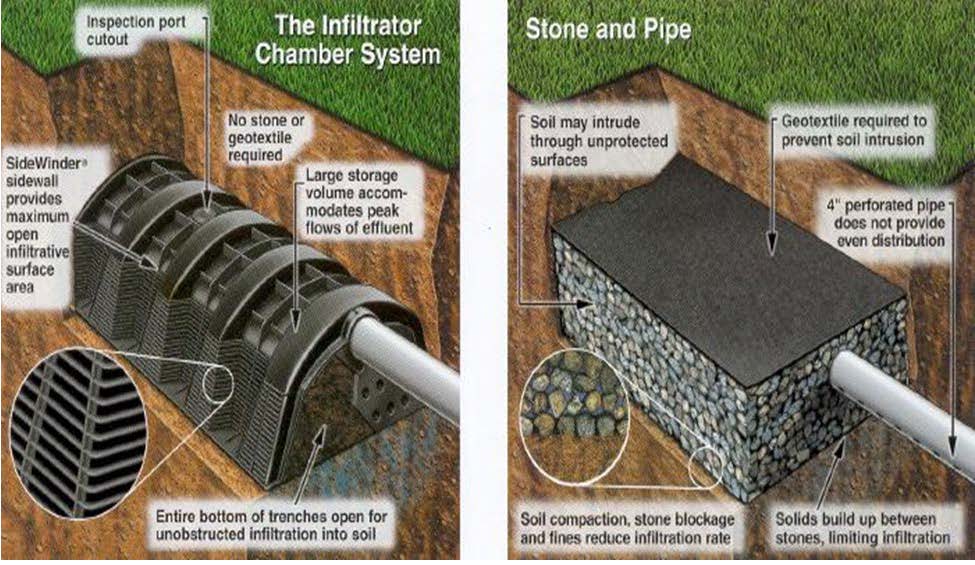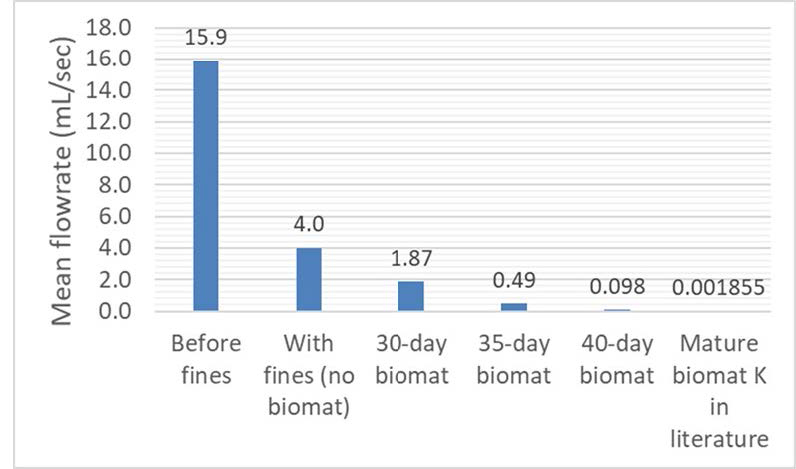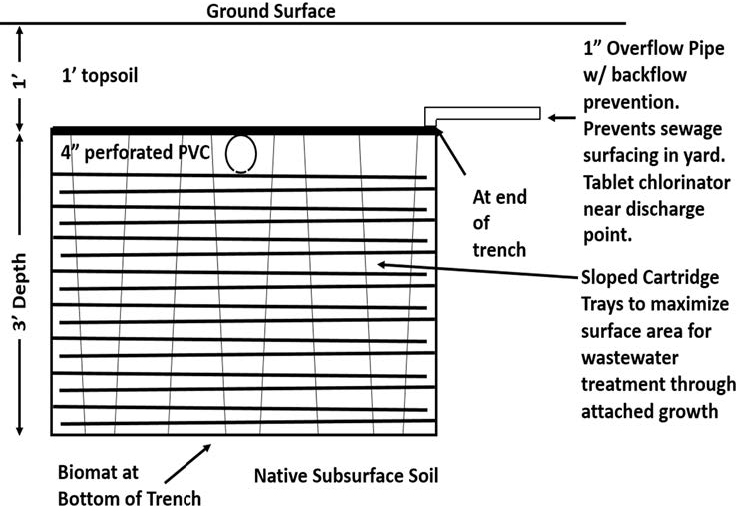Grantee Research Project Results
Final Report: Novel septic system design to prevent failure
EPA Grant Number: SU839288Title: Novel septic system design to prevent failure
Investigators: Elliott, Mark , Tick, Geoff , Terry, Leigh , Mortazavi, Behzad , White, Kevin
Institution: The University of Alabama
EPA Project Officer: Page, Angela
Phase: I
Project Period: February 1, 2018 through January 31, 2019
Project Amount: $15,000
RFA: P3 Awards: A National Student Design Competition for Sustainability Focusing on People, Prosperity and the Planet (2017) RFA Text | Recipients Lists
Research Category: P3 Awards , Sustainable and Healthy Communities , P3 Challenge Area - Safe and Sustainable Water Resources
Objective:
Our objectives for Phase I of this P3 project were:
- To better understand the nature and causes of septic system failures (both hydraulic and environmental); and
- To design and conduct preliminary testing on a modified septic system trench that delivered superior treatment performance and was practical to implement in the field.
The specific technical goals of the modified septic system trench were to lower probability of both hydraulic and environmental failure and attenuation of the adverse impacts of failure through degradation of organics, nitrification-denitrification and reduction of the concentration of infectious pathogens. To ensure that the design was practical and could be implemented on a large scale, we added the following constraint: both the cost and installation procedures had to be similar to existing conventional septic systems.
Context and Limitations of Current Designs: Approximately 25% of U.S. residents (80 million people) do not have a sewer connection and are responsible for treating their own wastewater onsite. The vast majority of onsite wastewater treatment systems (OWTS) are conventional septic systems.
Septic systems rely on solids settling and anaerobic digestion of solids in a septic tank, with septic tank effluent infiltrating into the ground through drainfield trenches (Figure 1E). Septic systems provide affordable and effective treatment of domestic wastewater in most soil and geological conditions. However, some soil and geological conditions can lead to two major types of septic system failure:
- Hydraulic failure: wastewater backs up onto the ground (or into the plumbing of the home)
- Environmental failure: inadequately treated wastewater adversely effects water sources off- site (e.g., causing algal blooms in ponds, fecal microorganisms contaminating water wells)
Hydraulic failure tends to occur when trenches become clogged or soils are impermeable; environmental failure occurs when effluent is quickly transmitted through the subsurface (e.g., in coarse sands or fractured media). In cases of failure, alternative advanced OWTS are typically used. However, alternative systems can cost up to ten times as much as conventional septic systems and installation of advanced systems is far more challenging.
The two major types of conventional septic system trenches have various advantages and disadvantages (see Figure 2E). Most notably, the gravel fill used in a traditional trench carries fines that enhance clogging. However, gravel also raises the elevation head, increasing infiltrative flux. But neither trench design uses the available space and residence time of wastewater for treatment.
Figure 1E: Conventional septic system cross-section showing tank, drain field and infiltration of effluent into the subsurface.
Figure 2E: The two major types of trench fill in septic systems. (a) Gravel-filled trench with PVC pipe and (b) Infiltrator® Chamber System.
Source of images: thenaturalhome.com/infiltrator.php
We proposed that the existing space and the corresponding wastewater residence time in a conventional septic system trench can and should be utilized to enhance wastewater treatment with no major changes to costs and installation procedures. Our design changes would decrease organic loading to the biomat, reducing hydraulic failure, and improve treatment of pathogens, nutrients and pharmaceuticals, reducing both the probability and consequences of environmental failure.
Consequences of hydraulic and environmental failure: Hydraulic failure of conventional septic systems can lead to exposure of residents to wastewater-associated contaminants, most notably fecal pathogens and intestinal helminths (worms). Exposure to untreated wastewater yields substantial health risks. In addition to gastrointestinal pathogens, there is very troubling evidence from Alabama that helminth (worm) infections are common in areas with poor onsite wastewater treatment. A survey of helminth infections in rural Alabama revealed that roughly 33% of children under-10 tested positive for one or more helminths (Badham, 1993). A recent survey of adults in another rural Alabama county found that 34% had signs of hookworm infection (McKenna et al., 2017).
Environmental failures typically occur offsite when inadequately treated septic tank effluent adversely impacts groundwater or coastal waters. With groundwater, the major concern is exposure to pathogens and other wastewater-associated contaminants from consumption of well water. For surface waters, the most frequently cited concern is from nutrient contamination leading to algal and cyanobacterial blooms; this type of failure has caused majors problems in Chesapeake Bay (MD Dept. of Environment, 2016) and Long Island Sound (Dooley and Schwartz, 2018).
Summary/Accomplishments (Outputs/Outcomes):
Outputs: Outputs planned in the Phase I proposal were described as follows: “Phase I outputs will be achieved through the design, building and testing of our lab-scale units. Outputs include initial and final designs, laboratory data produced, the Phase I report to EPA and Phase II proposal.”
| Shortcomings of Existing Systems | Our Solutions |
|---|---|
| "Fines" clogging from gravel | Use plastic/synthetic media |
| Systems wiht enhanced treatment are too expensive | Supplement conventional septic system design to add treatment |
| Installation of alternative systems too complicated | Use standard tank/trench with slight modifications |
| Wastewater in yards leads to majore health risks | Provide an emergency discharge outlet with chlorine disinfections |
| Helath risks offsite from environmental failure | Treatment in trenches decreases contaminant concentrations |
| Trench "reactor volume" is not utilized for treatment | Maximize contact of wastewater with biofilms and enable oxic conditions |
| Increased organic loading is associated with hydraulic failure | Decrease organic loading through organic matter degradation in trench |
We targeted a number of shortcomings in the two major conventional septic system trench designs as indicated in Table 1E. The role of fine particles attached to gravel fill in restricting flow both through physical occlusion of pore and through subsequent integration into the biomat was investigated in conjunction with students in Dr. Elliott’s spring 2018 CE 420: Environmental Measurements class (see Outcomes for further information).
The design, building and testing of our lab-scale units: Data reported in this section reflects progress made toward these outputs. Additionally, we believe that our identification of the residence time and space in the septic system trench, our investigation of its potential as a resource for improved system performance, and the parallels with advanced nitrogen removing OWTS represent intellectual contributions to the field.
Column-scale simulations of gravel-filled trenches were constructed (Figure 3E) and tested based on protocols reported previously (e.g., White and West, 2003). Washed local gravel reported to be used by septic system installers in the region was acquired from a quarry. Testing revealed that fines remaining in the gravel following washing reduced infiltrative flux by 75% after only three drain-fill cycles and by 99.4% after only 40 days of biomat growth. Based on biomat K values found in the literature and the 2-mm thickness of biomat/fines that we observed, a further 50-fold reduction in flux would occur with a fully mature biomat of the same thickness (see Figure 3E).
Figure 3E: Decrease in column flowrate with addition of fines and up to 40 days of biomat growth and anticipated flowrate for a mature biomat.
Proposed modified design: Our findings indicate that clogging from fines is a major obstacle to sustainable operation of conventional septic systems with mature biomats. Another practical implication is the inadequacy of standard “perc tests” for determining the suitability of soils if the septic system trench design includes gravel fill.
We continued our literature review subsequent to submission of our Phase I proposal and found that substantial nitrification-denitrification has been achieved in other onsite wastewater treatment systems (e.g., The New York State Center for Clean Water Technology, 2016).
However, these technologies cost five-to-ten times as much as a conventional septic system. By utilizing some of the same design features (e.g., unsaturated operation with attached growth), we propose that substantial reductions in total nitrogen can be achieved by the simultaneous presence of both oxic and anoxic conditions at different places within the trench (Figure 4E).
Additionally, hydraulic failure that causes untreated wastewater to emerge at the ground surface or back up into the home is a major threat to the health of residents. The “overflow pipe” would only operate when the system had failed (i.e. when pressure buildup forced wastewater above the trench). However, we believe that distant surface discharge with disinfection is far superior to a system backing up into the yard or the home with no disinfection (Figure 4E). Due to the utilization of surface discharge under failure, this design would require regulatory changes to enable its use in the United States.
Phase I report and Phase II proposal: This document serves as the final Phase I report. The planned submission of the Phase II proposal was cancelled due to personal/family issues. The PI’s wife gave birth to triplets in early-May 2018, precluding preparation and submission of the proposal by the mid-May deadline.
Figure 4E:https://cfpub.epa.gov/ncer_abstracts/images/fckimages/index.cfm?imgid=18268 Cross-section of modified trench design represented
under field use conditions (not to scale).
Conclusions:
In our Phase I proposal we identified the following as our anticipated outcomes: “While our long-term goals for this research include substantial water quality and health outcomes, measurable changes are infeasible given the research focus and length of Phase I. However, throughout the design and testing phases, we plan to engage with licensed installers through our existing partnership with the Director of the AOWATC who conducts all training and licensing. This will ensure that the system that we design will be practical and appealing to installers. Eventually, we hope that our system is widely adopted and improves human health by reducing the frequency and severity of septic system failures.” We have engaged with and continue to engage with Allen Tartt, Director of the AOWATC. We still hope that our system can be tested at full scale and eventually implemented widely.
Additionally, as stated in the Educational and Interdisciplinary Aspects section of the Phase I proposal, we wanted to increase knowledge of senior civil and environmental engineering students through lecture and lab activities: “Dr. Elliott plans to work with the student team members to integrate an onsite wastewater module into his lab-based course, CE 420, Environmental Measurements. The module will be a lab and lecture section designed for senior Environmental Engineering students. In addition to collecting and analyzing samples, course content will include the sustainability and pollution prevention aspects of identifying and preventing non-point source pollution. He is scheduled to teach the course in Spring 2018.” Fifteen environmental engineering students took part in an extended, three-week module on onsite wastewater, conventional septic system design, volumetric flow characteristics for system operation, and the role of fine particles in adversely affecting infiltration of effluent into the subsurface.
Supplemental Keywords:
sustainable water management, wastewater treatment, alternative OWTS, decentralized wastewater, environmental justice, rural poverty, TMDLThe perspectives, information and conclusions conveyed in research project abstracts, progress reports, final reports, journal abstracts and journal publications convey the viewpoints of the principal investigator and may not represent the views and policies of ORD and EPA. Conclusions drawn by the principal investigators have not been reviewed by the Agency.




